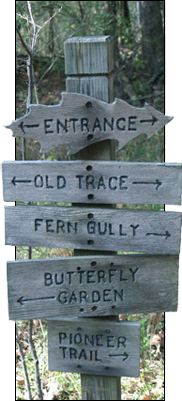
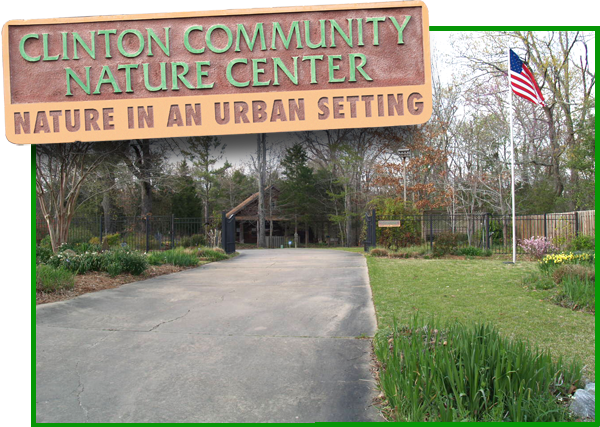
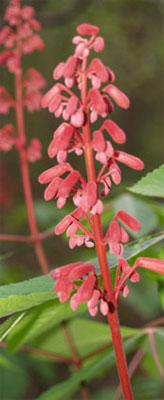
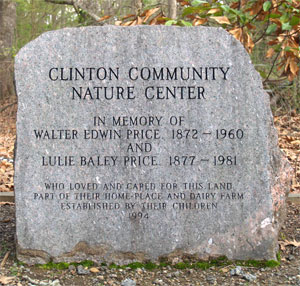
Hidden in the center of town, accessible from a residential street in a quiet neighborhood, is the Clinton Community Nature Center, comprised of more than 2-1/2 miles of all-weather walking trails that wind over 33 acres of land donated in the memory of Walter Edwin Price and his wife, Lulie Baley Price. The Nature Center was established in 1992 for the purpose of “teaching, study, enjoyment, and appreciation of nature in all its aspects...” by the citizens of the town of Clinton, Mississippi and the surrounding area. This goal has been accomplished through the efforts of volunteers working for the Nature Center with funds provided by memberships, grants, and donations to the nonprofit organization from local businesses.
This memorial stone (right), dedicated to Walter and Lulie Price, can be found on the trail side of Price Hall, opposite the parking area. The spacious hall (below) is manned by a volunteer staff. If you are interested in volunteering, please see the contact information at the end of this article.
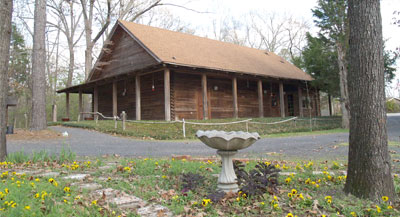
The entrance to the Nature Center is at the intersection of Dunton Road and Hester Street. Past the beautiful flower garden and through the gate stands the Nature Center’s education and administration building, Price Hall (left), which opened in April of 2000. Housing the Center’s offices and gift shop, the building also has a large room that serves as a classroom and display area. Besides playing host to Clinton Nature Day in April, the Center offers lectures on topics such as growing and cooking with herbs, environmental awareness, and fall vegetable gardening, to name a few. Summer Nature Day Camps for children provide hands-on nature activities. Click here to keep up with events and activities at the Nature Center.
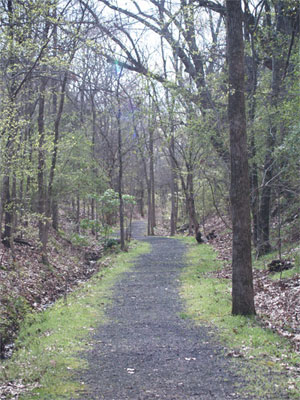
Outside, on trails where one could easily become turned around without the provided map, you’ll find signs labeling native trees, flowering annuals and perennials, and the local ferns that give Fern Gully—one of the trails—its name. Several large kiosks around the trails give further detailed educational information about the plants as well as the history of the region. For example, a part of the original Natchez Trace runs along the northwest border of the Nature Center (seen at right), so it’s likely that as you walk this portion of the trail, you are walking the same path trod by General Andrew Jackson, the naturalist-artist John James Audubon, and the murderous outlaw, Little (Wiley) Harpe, who met his end with his severed head stuck on a pole as a warning to other evildoers of the time. See our article on Mississippi River Pirates.
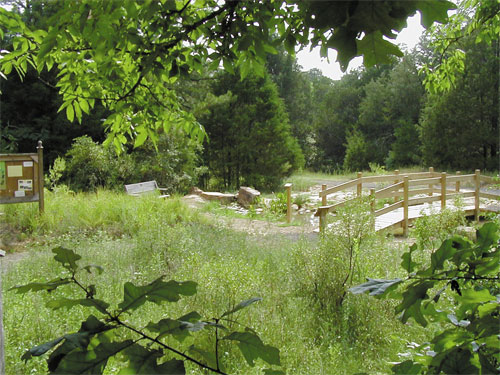
The eastern portion of the Old Natchez Trace (right) is surfaced while the western end has been left unfinished and can be a slightly more difficult trek depending on one's physical limitations, as well as upon the weather. However, most of the trails are quite easily navigated.
On a small hill overlooking the Butterfly Garden (pictured at left), there is an old stone cistern where stood the original Sumner Hill School, established for African-Americans before the end of the 18th century. In 1935, the school moved to its present location northwest of the Nature Center on Northside Drive. In the spring, the Old School Circle, as the path around the cistern is called, is thick with daffodils of a variety grown there since the 19th century.
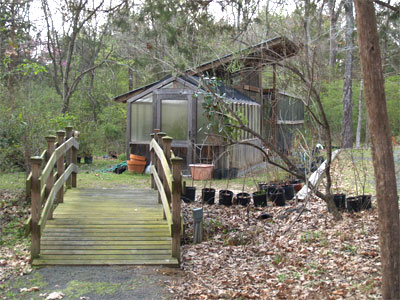
The trails of the Clinton Community Nature Center will be linked up with another set of walking trails being built around Clinton's Quisenberry Library, situated just north of the Nature Center. This project is scheduled to be completed in 2011.
Numerous benches along the trails allow visitors to rest and enjoy the quiet solitude of the woods, and a 100-seat amphitheater, built by the all-volunteer work force, rounds out the facility. Numerous small bridges and raised walkways guide you as you move along the various trails that bear such descriptive names as Fern Gully, Grape Vine Loop, Pine Woods Trail, and Cedar Lane. Raccoons and deer have been spotted on the grounds, but their tracks are more likely to be seen than the animals themselves. Of course, squirrels and a variety of birds, depending on the time of year, can be seen if one walks quietly enough.
The Whitfield Price Nursery (at right) hosts three plant sales each year in February, April, and October. Native plants, antique roses, and bedding plants and perennials are for sale depending on availability and season.
The Clinton Community Nature Center’s trails are open from 7:00 am until sunset daily.
Price Hall is open for visitors from 9:00 am until 4:30 pm Monday through Saturday, and from 1:00 pm until 4:30 pm on Sunday.
For more information on the Clinton Community Nature Center, please call 601-926-1104
or you may send e-mail to ccnaturecenter@gmail.com.
As always, when spending any time outdoors in Mississippi, dress accordingly depending on the weather and season, use insect repellant when needed, and during the summer heat and humidity, drink plenty of water.
COPYRIGHT © THE NEW SOUTHERN VIEW EZINE | 4/4/11

